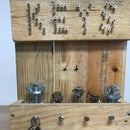Introduction: Threaded Rod Pallet Shelf
Albany County Fasteners loves all of the cool things we see our customers make with our fasteners all the time. So much so that we decided "Hey, why don't we make some cool stuff of our own?" And we set out to do just that. For our first ever pallet art project we have decided to make a threaded rod pallet shelf! But where's the fun in that if you can't help other people build it as well? Below is a step by step guide including references to all of the fasteners we used to make this shelf so you can make one for yourself!
Tools Used In This Project
- Circular Saw with Wood Blade
- Cordless Drill
- #2 Phillips ACR Power Bit
- 1/2" Spade Bit
- Contractor Pencil
- Tape Measure
- Hammer
- Painters Tape
- Lebel
- 3/4" Wrench
- Safety Glasses
- Safety Gripping Gloves
All Supplies Needed
- 36 Planks From Pallets
- 18 - 2 Foot Planks
- 18 - 10-1/4" Planks
- 54 1-1/4" #8 Stainless Steel Phillips Flat Head Wood Screws
- 52 1/4" Zinc Serrated Flange Nuts
- 4 1/4" 6 Foot Zinc Threaded Rod
Step 1: Find the Wood and Remove the Nails
The first step in our process was finding acceptable wood and removing nails. Before we begin lets put on some safety gloves and goggles and get to work. We chose eighteen 3" wide planks for the shelves and nine 4" wide planks for the cross beams. Then we used two already loosened planks of wood to pry out the rest with ease. Using this method makes removing pallets from wood a breeze. Then we straightened out the nails and hammered them out. Pro Tip: Using another pallets gaps to hammer nails out makes removing these nails simple.
Step 2: Measure, Mark and Cut
Once we had our wood laid out according to width, we cut the 3" wide segments into 2 foot lengths. We eyed each piece carefully looking for splits or extensive warping to ensure we had suitable wood. Then we took the 4" wide boards and marked out two 10-1/4" lines so we could cut two lengths out of each board. Finally we were able to cut those lengths leaving us with eighteen 2 foot x 3" pieces and eighteen 10-1/4" x 4" pieces.
Step 3: Assembling the Shelves
In this step we lined up 3 of the 10-1/4" boards and then laid 3 of the 2 ft boards across them. Using blue tape to help discourage splitting and cracking, we place 9 wood screws into it to hold them in place. Note: Make sure one side (the front) is flush. If the back is a little crooked its ok because it will be against the wall.
Step 4: Drilling the Holes
Our next step was to drill 1/2" holes into the corners of each shelf to pass the threaded rod through it. After you drill holes into the first one, line up all of your shelves and make sure you have all of the fronts facing a single direction. Line up the first shelf you cut with the rest and use it as a guide to drill the rest of the corner holes. Since most pallets are warped and will vary slightly this will ensure that all of your shelves line up evenly.
Step 5: Installing the Shelves
Our next step is to add flange nuts to the base of the threaded rod as feet and to hold the shelving. After sliding on each level of shelving to the threaded rod follow with a flange nut to hold each shelf down. Make sure during this you space your shelves somewhat evenly. Once all shelves are attached measure out distances for each shelf (we chose 13") then measure each corner of the shelf to make sure every corner is the same height. Start from the bottom and move up shelf by shelf until each shelf is even.
Next place a level on the bottom shelf. Use the feet on the bottom to adjust the first shelf until it is level. Now work your way up the shelves using the level and lower flange bolts to level each shelf. Once finished, tighten the top flange bolts and then the bottom ones. This will significantly tighten up your shelf making it sturdy.
Step 6: Decorate!
Now that your shelf is complete, its time to use it! We chose to decorate our kit with some of our useful tools and projects. We also added Tall cap nuts to the top to polish it off nicely.

Participated in the
Furniture Contest 2017












